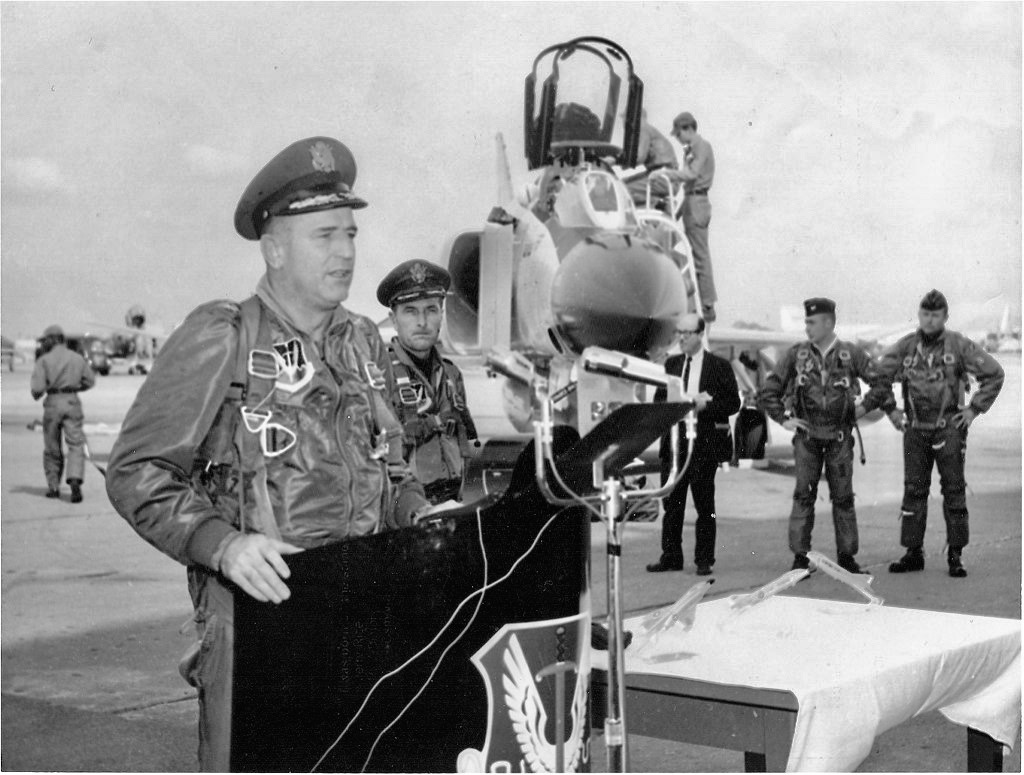
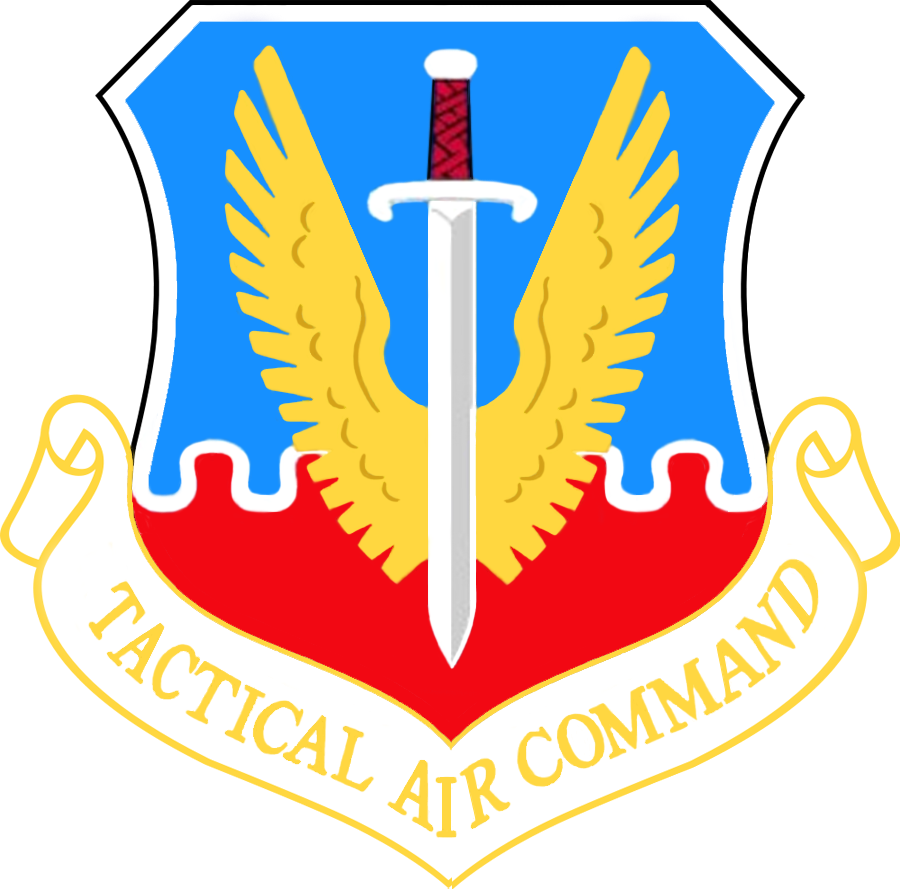 20 November 1963: The U.S. Air Force Tactical Air Command accepted its first two production McDonnell F-4C Phantom II jet fighters, F-4C-15-MC 63-7415 ¹ and F-4C-15-MC 63-7416. These aircraft were the ninth and tenth production F-4Cs. They were flown from the McDonnell plant at St. Louis, Missouri, to MacDill Air Force Base, Tampa, Florida, by Brigadier General Gilbert Louis Meyers, commanding the 836th Air Division, and Colonel Frank Kendall (“Pete”) Everest, a world-famous test pilot, commanding the 4453rd Combat Crew Training Squadron. Co-pilot for General Meyers was Captain Joseph D. Moore. Captain Thomas C. Ross flew with Colonel Everest. The two new fighters arrived at 11:00 a.m., local time.
20 November 1963: The U.S. Air Force Tactical Air Command accepted its first two production McDonnell F-4C Phantom II jet fighters, F-4C-15-MC 63-7415 ¹ and F-4C-15-MC 63-7416. These aircraft were the ninth and tenth production F-4Cs. They were flown from the McDonnell plant at St. Louis, Missouri, to MacDill Air Force Base, Tampa, Florida, by Brigadier General Gilbert Louis Meyers, commanding the 836th Air Division, and Colonel Frank Kendall (“Pete”) Everest, a world-famous test pilot, commanding the 4453rd Combat Crew Training Squadron. Co-pilot for General Meyers was Captain Joseph D. Moore. Captain Thomas C. Ross flew with Colonel Everest. The two new fighters arrived at 11:00 a.m., local time.
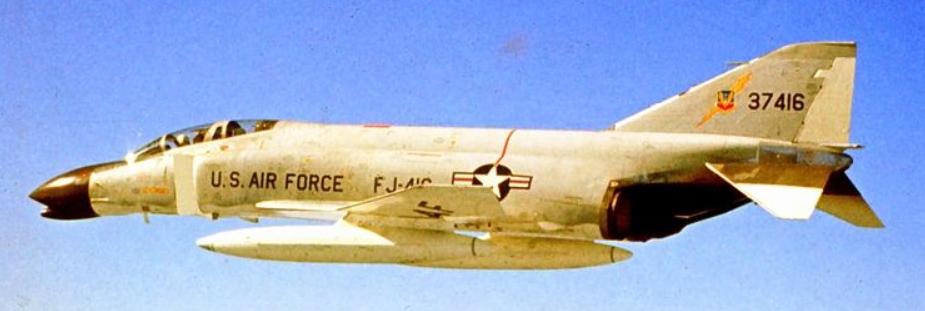
Lieutenant General Charles B. Westover, Vice Commander, Tactical Air Command, formally accepted the new fighters on behalf of TAC. Up until this time, the 4453rd had been training crews with McDonnell F-4B Phantom IIs on loan from the United States Navy.
The Tampa Tribune reported:
New Tactical Fighters Give MacDill Wings Heavier Punch
By JOHN McCARTHY, Tribune Staff Writer
At 11 o’clock yesterday morning at MacDill Air Force Base, necks craned, and all eyes were skyward as two F-4C tactical fighter aircraft roared into view—the vanguard of a 1,000-plane order to replace outdated planes in the Tactical Air Command.
The two planes, each costing a million dollars, were piloted from the St. Louis plant of McDonnel Aircraft yesterday by Brig. Gen. Gilbert L. Meyers, commander of the 836 Air Division at MacDill, and Col. Frank K. Everest, commander of the 4453rd Combat Crew Training Squadron.
For the historic event, a special ceremony was held on the MacDill flight line, attended by military and civilian leaders.
The pair of F-4C “Phantoms” zoomed into view, made a low, high-speed pass over the flight line and were almost out of sight in the blink of an eyelash.
After a quick circle over MacDill, the two planes taxied toward the spectator area—each trailing colorful orange and white parachutes which are used to lower the plane’s landing speed.
The two officers eased themselves out of the enclosed cockpit to receive congratulations from Lt. Gen. Charles B. Westover, vice commander of Tactical Air Command, Langley Air Force Base, Va., and other military leaders.
Wearing a broad grin and looking like a man freshly arrived from home to office, rather than from St. Louis, Gen. Meyers enthusiastically commented “it’s a wonderful flying machine.”
The youthful appearing Air Force general said we “loafed along at 550 knots” during the 1½ hour trip from the St. Louis plant. This is 635 miles per hour in land speed and considerably under the Phantom’s top speed of over 1,600 m.p.h.–twice the speed of sound.
General Meyers said when he first flew over 400 m.p.h. in an Air Force plane he was thrilled.
“I’m sure as long as we (the Air Force) keep receiving this kind of equipment, along with the dedication of the men, this country has nothing to worry about,” he told the crowd.
General Westover, who accepted the first two planes on behalf of TAC, noted the new models would be part of the Air Force weapons inventory for at least five years. The Air Force has placed a $2 billion order with McDonnell Aircraft.
A twin seat, dual engine jet plane, the Phantom has been used by the Navy since December, 1960. The Air Force version is modified with dual controls to permit the back seat man to pilot the plane.
The stubby-winged Phantom is capable of three times to bomb load of a B-17 bomber during World War II, coupled with the advantage that it carries its own protection and does not need a fighter escort.
The 12th and 15th Tactical Fighter Wings and the 4454th Combat Crew Training Squadron at MacDill will be the first Air Force units to be equipped with the new planes.
—The Tampa Tribune, Vol. 69, No. 325, Thursday, 21 November 1962, Page 15, Columns 1–3
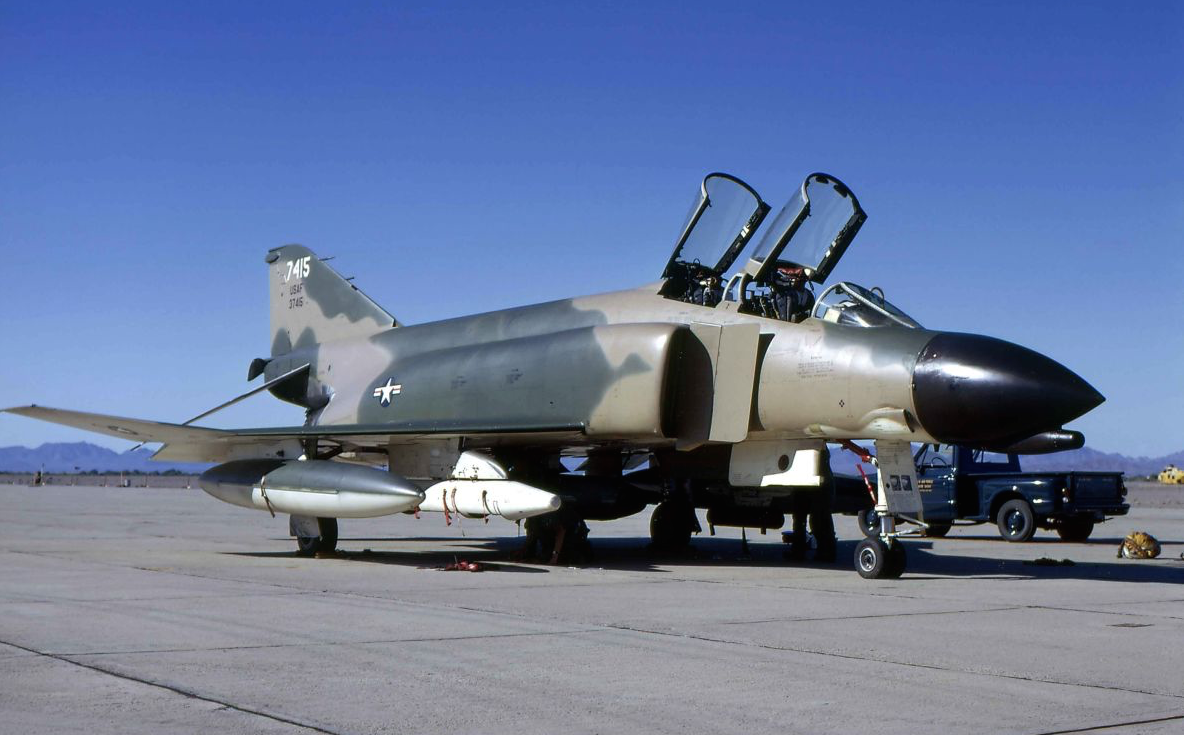
![]() The McDonnell F-4C Phantom II (originally designated F-110A Spectre) was produced for the U.S. Air Force, based on the U.S. Navy McDonnell F4H-1 (F-4B after 1962) fleet defense interceptor. Evaluation testing had shown the the Navy’s F4H was superior to the Air Force Convair F-106 Delta Dart. It was faster, could fly higher, had a longer range and greater payload. It was also better suited as a tactical fighter.
The McDonnell F-4C Phantom II (originally designated F-110A Spectre) was produced for the U.S. Air Force, based on the U.S. Navy McDonnell F4H-1 (F-4B after 1962) fleet defense interceptor. Evaluation testing had shown the the Navy’s F4H was superior to the Air Force Convair F-106 Delta Dart. It was faster, could fly higher, had a longer range and greater payload. It was also better suited as a tactical fighter.
The Navy operated its Phantom IIs with a pilot and a radar systems operator. The Air Force’s F-4C variant was equipped with dual flight controls and was flown by two rated pilots. The F-4C was externally the same as the F-4B, but otherwise differed by the addition of a ground attack capability. Also, while the F-4B used a hose-and-drogue system for air-to-air refueling, the F-4C was equipped with a boom refueling system. It retained the folding wings and arresting hook of the Navy variant, but deleted catapult provisions.

The F-4C was 58 feet, 3¾ inches (17.774 meters) long, with a wingspan of 38 feet, 5 inches (11.709 meters) and height of 16 feet, 3 inches (4.953 meters). Its empty weight was 28,496 pounds (12,926 kilograms) and its maximum takeoff weight was 58,000 pounds (26,308 kilograms).
 The F-4C-15-MC was powered by two General Electric J79-GE-15 engines. The J79 is a single-spool, axial-flow turbojet engine, with a 17-stage compressor section and 3-stage turbine. The J79-GE-15 is rated at 10,900 pounds of thrust (48.49 kilonewtons) and 17,000 pounds (75.62 kilonewtons) with afterburner. It is 17 feet, 4.7 inches (5.301 meters) long, 3 feet, 2.3 inches (0.973 meters) in diameter and weighs 3,699 pounds (1,677.8 kilograms).
The F-4C-15-MC was powered by two General Electric J79-GE-15 engines. The J79 is a single-spool, axial-flow turbojet engine, with a 17-stage compressor section and 3-stage turbine. The J79-GE-15 is rated at 10,900 pounds of thrust (48.49 kilonewtons) and 17,000 pounds (75.62 kilonewtons) with afterburner. It is 17 feet, 4.7 inches (5.301 meters) long, 3 feet, 2.3 inches (0.973 meters) in diameter and weighs 3,699 pounds (1,677.8 kilograms).
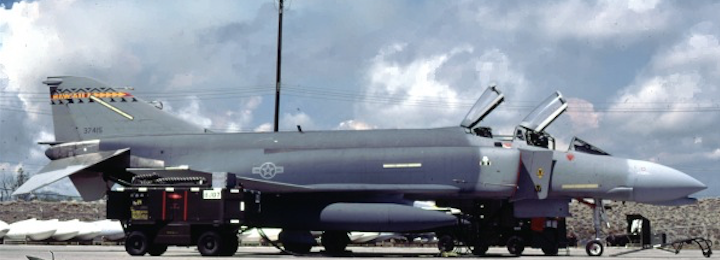
The F-4C had a maximum speed of 826 miles per hour (1,329 kilometers per hour)—Mach 1.09—at Sea Level, and 1,433 miles per hour (2,306 kilometers per hour)—Mach 2.17— at 48,000 feet (14,630 meters). The fighter’s service ceiling was 56,100 feet (17,099 meters). Its maximum unrefueled range, with external fuel tanks, was 1,926 miles (3,100 kilometers).
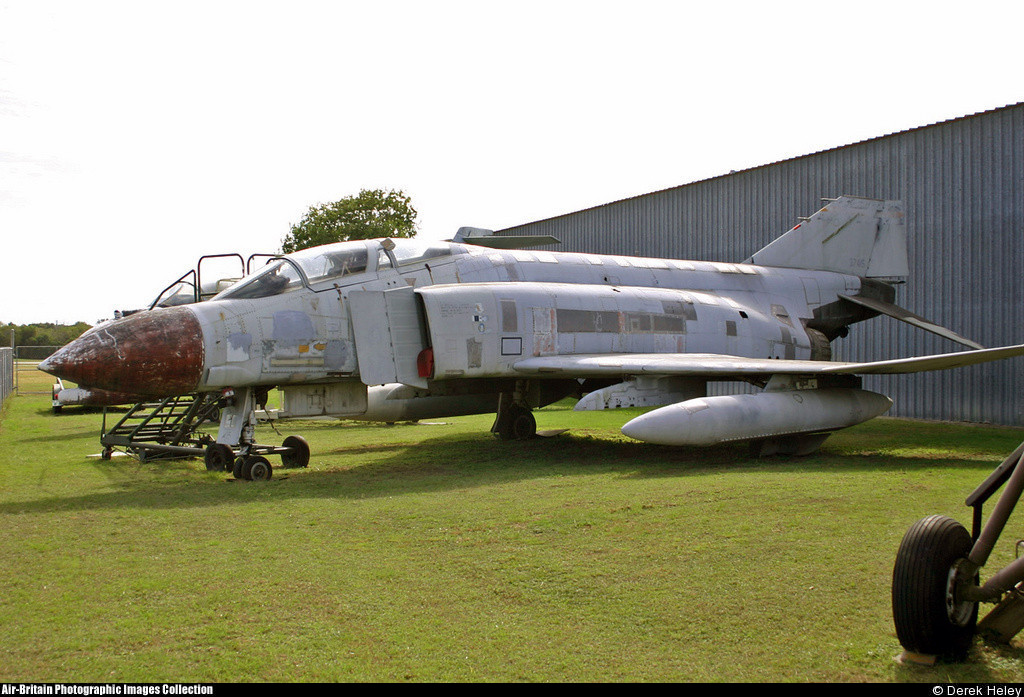
The standard armament for the F-4C were four AIM-7 Sparrow radar-homing missiles carried in recessed in the bottom of the fuselage. Four AIM-9 Sidewinder heat-seeking missiles could be carried on underwing pylons. A maximum of 16,000 pounds (7,257 kilograms) of bombs could be carried on five hardpoints.
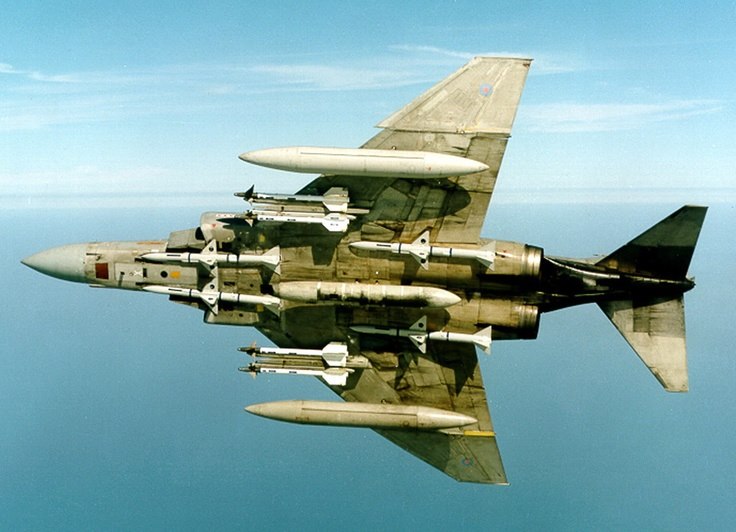
During the Vietnam War, the missile armament of the Phantom II was found unsatisfactory in dogfights with enemy aircraft. The violent maneuvers of Air Combat Maneuvering (“ACM”) made it difficult for the missiles to align and track the intended target. Of 612 AIM-7 Sparrows fired by F-4s, only 56 enemy aircraft were destroyed, while 187 AIM-9 Sidewinders brought down 29 enemy aircraft. This was a kill ratio of 9% and 16%, respectively.
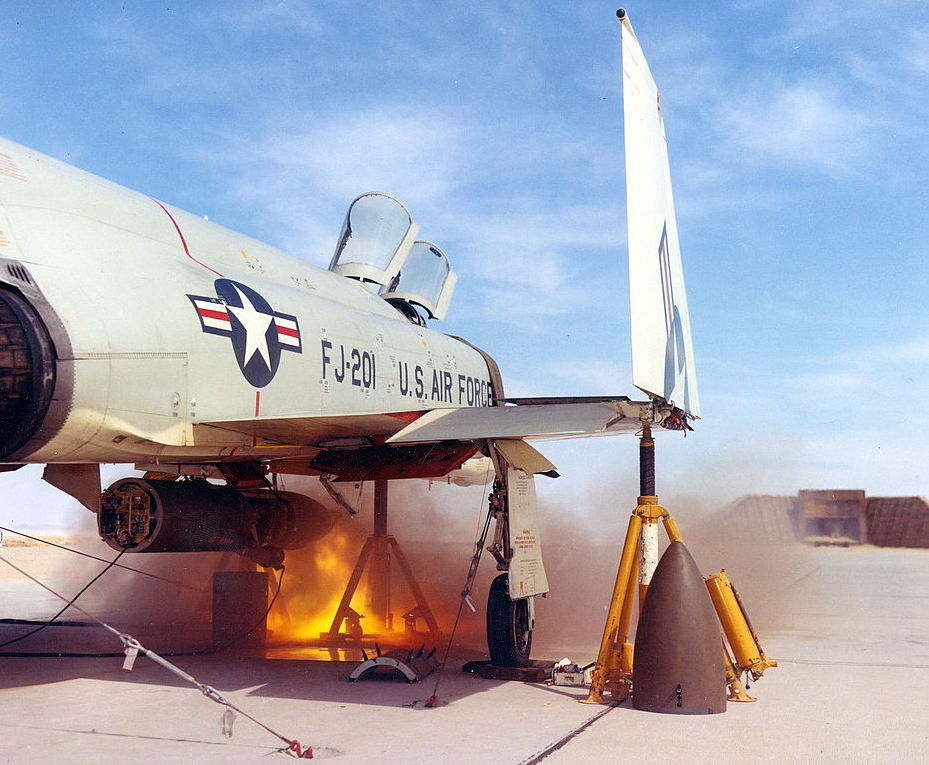
Forward-thinking planners had assumed that an all-missile armament was all that was required in the modern era, so F-4s were built without any machine guns or cannon. The Air Force used an SUU-16/A pod containing a General Electric M61A1 20 mm rotary cannon with 1,200 rounds of ammunition mounted to the F-4’s centerline hardpoint. (Two additional SUU-16/A pods could be mounted on the outboard underwing hardpoints.) This was useful in close-in combat, but the airplane was not equipped with a suitable gun sight. It was not until the F-4E variant that a gun was incorporated into the airplane.
McDonnell F-4C 63-7416 crashed at the Avon Park Bombing Range, Florida, 22 May 1964, killing both pilots, Captain Joseph P. Onate and Captain William F. Buhrman.
The F-4C first flew 27 May 1963. 583 of this variant before production shifted to the F-4D in 1966. The F-4C remained in service until the last was retired from the Oregon Air National Guard in 1989.
Recommended reading: Engineering the F-4 Phantom II: Parts Into Systems by Glenn E. Bugos, Naval Institute Press, Annapolis, Maryland, 1996
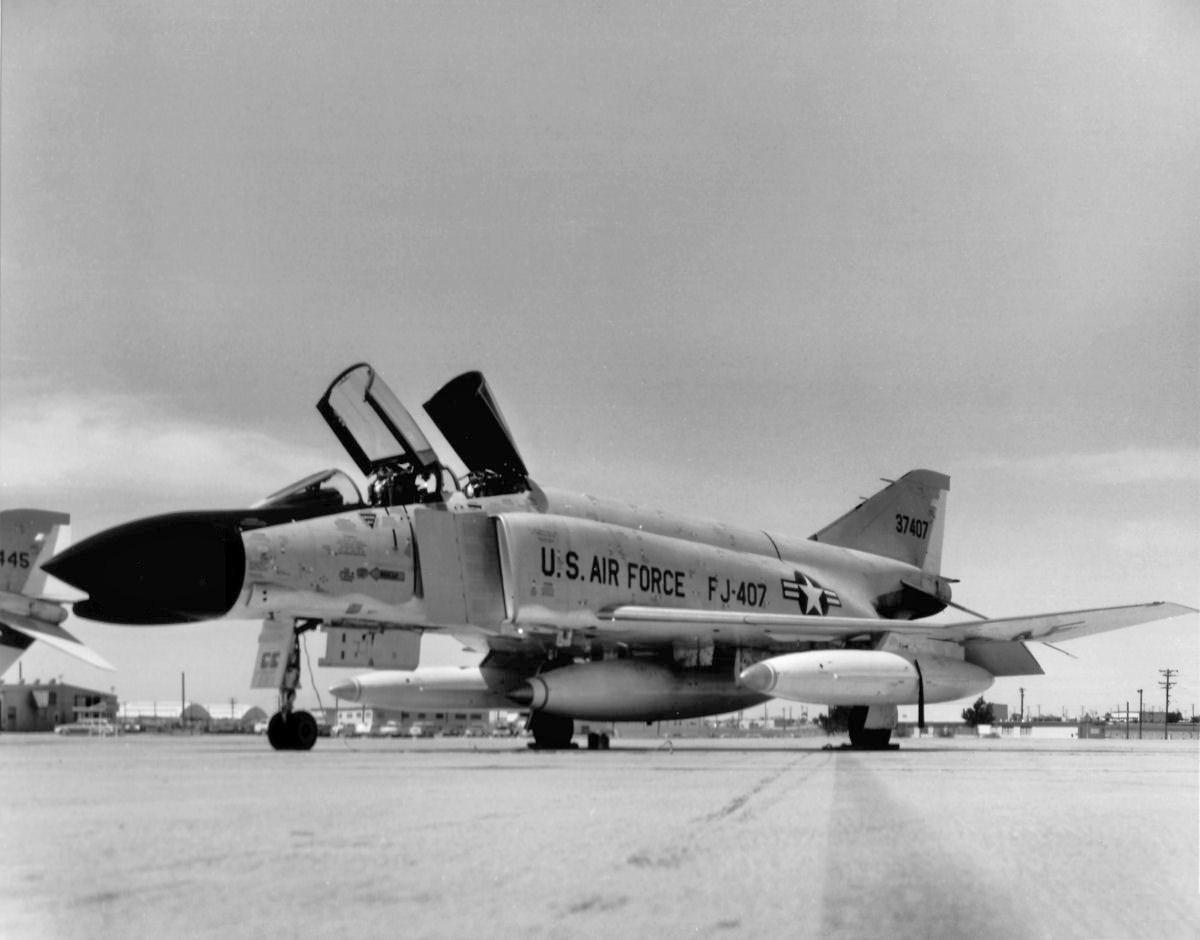
¹ Source: UNITED STATES AIR FORCE STATISTICAL DIGEST FISCAL YEAR 1964 (19th Edition), Directorate of Data Automation (AFADA), Comptroller of the Air Force, Headquarters, USAF, Washington, D.C.: Chronology of United States Air Force Major Events— FY 1964, at Page XXXVIII
© 2022, Bryan R. Swopes
It is mentioned above that F-4D production began in 1966. I am quite sure production was earlier. I was a radar tech and stationed at George AFB from 1964-65 where we were prepping F-4Cs for SE Asia when a few 4Ds came in and we noticed the absence of the IR on bottom of radome, and there were some radar changes. At my age of 79 I might be off base. What say you? ?
Thanks, John. I rechecked and a usually reliable source states that the first flight of an F-4D took place 7 December 1965, and deliveries to the Air Force (36th TFW, Bitburg, Germany) began in in March 1966. Most (not all) F-4Ds had a larger radome to accommodate a different radar system. Also, the F-4D lost the capability to carry Sidewinder missiles in favor of the AIM-4 Falcon. Ron Downey’s excellent “Aviation Archives” site (http://aviationarchives.blogspot.com/) shows that the AAA-4 IRST system was deleted in Block 25 F4Cs.
Radar Dish on C’s and D’ was the same Diameter very little difference in Radars. D models had a better Ground Mapping mode. McDonnell Avionics Tech Rep.
I remember seeing some D models coming into Selfridge from the Kansas ANG in 1986-87 that had 1965 serial numbers.
I was stationed at Eglin AFB in ’65 when the 33rd TFW was getting the new C’s from the factory. This was late ’65 and all of us newcomers had to go through FAM school before we could touch one. I think we were still getting C’s into ’66. I left for Vietnam in Dec of ’66. I would say that the beginning of production of the D’s beginning in ’66 is pretty close. I remember that we got a few in before I shipped out to Cam Ranh in late ’66.
The F4C also had bumps on the upper and lower surfaces of the inner wing to accommodate the larger tire that the Air Force used. I did the lofting for those bumps.
An excellent detail. Thanks, Dwight! I believe that your drawings can be seen at: https://lh3.googleusercontent.com/-IOZweqR4A88/V5kOlwmyGyI/AAAAAAAAITU/xT6l9js7OuE/s1600-h/F-4-Wing-Bumps-details-13.jpg
I worked Ds (66s) at Nellis (474th) we had AIM 9Bs never could slave to target
Why would there be two rated pilots?
The U.S. Navy operated the F4H-1 and F-4B with a pilot and a radar intercept officer (rated as a Naval Flight officer). The U.S. Air Force, though preferred to use to rated pilots, so the rear cockpit of the F-4C was equipped accordingly. During the Vietnam War, the Air Force shifted to a non-pilot Guy in Back.
My Instructor in T-37’s (1968) was a former Vietnam vet F-4 backseater (GIB). There were a couple of others in my squadron. I’m sure they flew in the early years of the war. Later, Navigators were in the back seat, but they still had flight controls back there and they learned to fly the airplane to relieve the front seater or in an emergency.
John Holden: I got out of the Navy (VF-101) as a radar tech (AQ2)nine days after the Air Force got the F4C delivered and worked on the f4s the entire time. I’ve been wondering when the IR small radome under the main radome was deleted and you’ve informed me that it was with the F4D in December of ’65. The Navy never did anything with that small radome but the back seat radar scope did have a small “red line follower dot” tracking back and forth with the antenna. Thanx for the info.
Pete Everest was called Speedy Pete because he held the world speed record in aircraft for a time. My father worked with him in the late 50’s and early 60’s when stationed in Tripoli.
I was a WSO in the F4E 75-82. Loved the F4.
Except they used a picture of a British F-4K in one of the pics.
I am in the 184th KANG and we definitely had both 65 and 66 year tail numbers of F-4D’s
The article’s top speed numbers are a little slow as well. But still a great day in History that the greatest Air Force accepted one of the most important and influential and lethal aircraft to ever fly
Thanks, Ron. Good catch on the British Phantom. Was it the exhaust nozzles? Surprising that I haven’t been able to find a bottom view of a USAF F-4C with missiles and gun pod. . . All performance figures in the article are from a USAF Standard Aircraft Characteristics document.
I was a crew chief on F-4Es but I’m pretty sure all models of Air Force F-4 s had hydraulic brakes while the Navy had pneumatic brakes, which meant the bleed valves for the brakes were at the bottom of the system to remove any water buildup in the pneumatic system. (Apparently the Navy didn’t have to use the brakes much on a carrier so brake fade wasn’t an issue for them) It took a while to get air out of the brakes on AF birds.
The Navy had a Ram Air Turbine (RAT) for backup hydraulic/electric power, the AF wanted a battery (in the E model, I don’t know about the Cs & Ds) so McDonnell Douglas found a place for it in the rear cockpit under the console by the right rudder pedal, officially you had to disconnect the rudder pedal to remove the battery- we almost always had a buddy in front step on the right rudder pedal and depress the brakes – we could get the battery replaced without disconnecting the pedal. (But it wasn’t easy)
The AF F-4Es had both antiskid and anti spin brakes. Anti skid for landing and on departure when the gear was retracted the brakes were automatically applied to stop the main wheels spinning (the 7 steel rotors of the brakes and the wide wheel/tires made for some unwanted gyroscopic forces during retraction)
All F-4s had 6 foot long main landing gear struts and 5 foot MLG wheel wells, there was a shrink link on the strut that compressed the strut as it retracted. If the struts were serviced with too much air the shrink link could break and cause the gear to try to extend in the wheel well – causing a gear up landing. (Not good for the crew chief, or the aircrew)
Good info. Thanks, Joel.
McDonnell Douglas – could you please correct my spell check error in my post. Apparently spell check likes old MacDonald from the farm.
Fixed. 🙂
I observed mach 2.4 on a F4D flown from Bitburg AB before hard points were installed on a newly delivered F4 – What a great aircraft – 1000 hours plus – half in front seat and half in the back
Wasn’t there a very exclusive club for pilots who had reached Mach 2 in the Phantom?
I REFUELED F-4B IN THE USN ABOARD THE USSAMERICA CVA-66 AND THE USS ENTERPRISE CVA(N)-65 1964 TO 1967. AND THEN WAS A CREW CHIEF ON F-4C, F-4D, F-4E IN THE USAF 1968 TO 1985
I was stationed at Mac Dill with the 12 tfw 555 tfs.
I remembered that day. I became a Crew chief on that great acft proud to be the first unit with the F4C and worked with such great airmen
I was stationed at Davis Monthan afb June 64-68 operated ground refueling trucks. 4453rd was our busiest customer. I witnessed on Dec 1967 F-4 crash into shopping center. Sad event
Just one comment on the gun pod – the SUU 16/A: We mounted them on our F4J’s at VMFA 115 and did not have very good success with them. Generally they would fire maybe 100 of the 1200 rounds and then quit. Firing the gun while pulling g’s would get you maybe a 1 second burst before it quit. Not sure what the problem was.
I was at Shaw AFB SC in 1966 we were getting new RF4C with a very few hours on them.